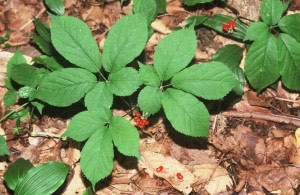You might have a hard time finding wild ginseng in the future woods, thanks to one of our most abundant herbivores: the white-tailed deer. Though deer populations are temporarily low in some areas, overall deer populations across the eastern United States are at an all-time high and are taking a toll on forest vegetation. Dr. James McGraw and his research assistant at West Virginia University, Mary Ann Furedi, published research in the February 2005 issue of Science pointing to whitetails as the culprit in the steady decline of this medicinal woodland plant.
Ginseng (Panax quinquefolius L.) is a small, herbaceous plant with bright red berries that grows in the understory of rich forests from Maine to Georgia. Especially in the southern Appalachians, it’s an important source of extra income for people who harvest the roots for lucrative Asian markets. Pickers are generally required by law to plant a seed for each plant harvested.
McGraw and Furedi, working in West Virginia, monitored seven ginseng populations every three weeks for five years, and early on, they noticed a troubling disappearance of plants. They suspected careless harvesting by humans but were forced to reevaluate their suspicions after finding the root structure of each plant intact. Hidden cameras revealed the true perpetrators: deer that repeatedly grazed the foliage of ginseng plants, eventually causing them to die.
The researchers then formulated a model showing how populations of ginseng with different numbers of individuals and rates of browsing by deer would fare over time, and their results are not encouraging. To have a 95 percent chance of survival over 100 years, a ginseng population would need at least 800 individual plants. Most populations they surveyed had only a few dozen plants.
But the real concern doesn’t end with ginseng – in fact, that’s where it begins. Ginseng is a popular plant to study because of its economic value, so other, less-studied plants are likely facing the same or a worse fate.
“Ginseng is probably the best-studied forest herb in North America – there are literally hundreds, thousands of herbs that have not been studied at all,” says Thomas Rooney, a forest ecologist at the University of Wisconsin. Other understory, herbaceous species that deer love include some of our most lovely wildflowers, like lady’s slippers and trilliums.
A burgeoning deer population throughout the Northeast bodes poorly for many of our delicate forest plants and wildflowers – but what can be done? McGraw and Furedi give three suggestions: do nothing, reintroduce natural predators of deer (like wolves), or re-examine our policies on deer hunting. Any of the options is bound to meet with resistance from some.
In their paper, McGraw and Furedi conclude that deer browsing must be curtailed by 50 percent to ensure a 95 percent survival rate for the populations they studied. Though increased deer hunting might be more acceptable to the public than reintroducing large carnivores, the researchers warn that the most effective hunting strategy would target does, but killing does tends not to be looked on favorably by hunters and non-hunters alike.
“People have to understand that there needs to be a balance,” says McGraw. The first option, to do nothing, perhaps dooms the entire herbaceous forest understory. “Without more effective deer population control,” the authors conclude, “ginseng and many other valuable understory herbs are likely to become extinct in the coming century.”



Discussion *